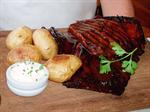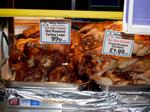 Choosing meat and poultry
Choosing meat and poultry
When choosing meat you have a number of different types to choose from and in the end, your final decision will depend on your personal preference, the cost of different types and also relate to what type works best in a particular recipe. Here are some general things to consider when choosing which meat to buy:
Firstly, decide which meat will work best n your chosen recipe. Types of meat to choose from include beef, pork, lamb and chicken. Beef is one of the most popular types of red meat, and is used in thousands of different recipes e.g. in casseroles, lasagne, chilli, hamburgers, and steak. While pork is considered to be healthier than beef because it is less fatty and typically is leaner than beef. Chicken can also be used in thousands of different recipes and depending on the preparation method, can also be a low fat choice e.g. skinless chicken only contains 3% fat.
Once you have chosen the type of meat you wish to cook, select your meat by examining its appearance/colour as this is a good indicator of freshness. Beef should have a bright red colour while pork should appear pinkish and the skin on poultry should be white or pale yellow. Marbling of meat also helps impart flavour so look for thin white streaks for a juicier and tenderer cut of beef.
When cooking for friends and family you may also like to choose varieties of meat that are lower in fat and therefore healthier. Most meat sellers will sell skinless chicken breasts and thighs which are extra lean. The majority of pork cuts are also lean and extra-lean ground beef s also widely available.
Next, check to see how meat smells as smell is a good indicator of quality. Meat should smell fresh and any rancid or strange smelling meat should be avoided. Finally, choose the correct cut of meat. There are two main cuts of meat to choose from- tough and tender. Tough cuts of meat care cheaper and contain muscle which requires braising or stewing to become tender, meanwhile tender cuts of meat should be cooked more quickly to help them retain texture and flavour.
Storing meat and poultry
It is essential for meat and poultry to be stored in the right conditions to stop bacteria from spreading and causing food poisoning. Raw meat/poultry should be stored in a clean sealed container on the bottom shelf of the fridge so that no part of the meat or juice can come into contact with other foods. Care should be taken to follow any storage instructions on the label and meat should not be used beyond its 'use by' date. Fresh meat/poultry can generally be stored in a refrigerator for 3 to 4 days ad in a freezer for up to 3 months. Cooked meat should generally be consumed within 2-3 days
 Cooking meat and poultry general tips
Cooking meat and poultry general tips
Meat and poultry can be cooked in a variety of different ways as we shall discover. However, regardless of the cooking method used, here are some tips to take into account:
1)
Do not overcook:
When cooking meat, like anything else, it is important that it not be over-cooked. Overcooking meat causes it to become dry or tough. Remember also that cooking times are different for different types of meat and it is therefore essential to refer to the cooking times stated on the particular meat you are buying or ask a butcher for additional guidance.
2)
Check meat is thoroughly cooked:
Whilst it is important not to over cook meat, under cooking is also a problem and for some meat such as pork and chicken. These meats can are susceptible to food poisoning bacteria and must always be fully cooked by whatever cooking method is used. To ensure pork and poultry is fully cooked the best method is to prick a folk or skewer in to the thickest part of the flesh and check that the escaping juices run clear rather than bloody. Also if you note any sign of red or pink meat further cooking time is required. On the other hand, it is acceptable for beef to have a pink tinge and many people will prefer it to be served in this way.
An extract from Food Preparation, Distance Learning Course, ACS Distance Education www.acs.edu.au